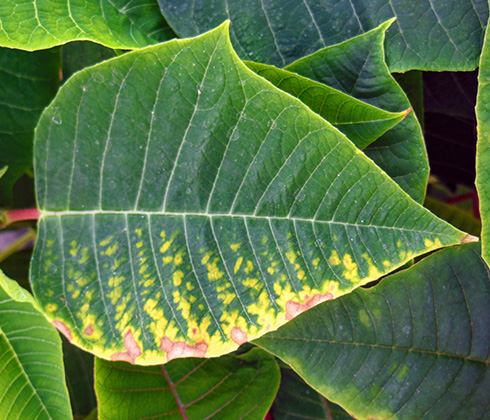Magnesium deficiency in poinsettia
Poinsettias exhibiting interveinal chlorosis (yellowing) in older leaves is an indicator of magnesium (Mg) deficiency.

During poinsettia (Euphoria pulcherrima) production, growers often provided a high level of nutrients because these plants are considered “heavy feeders.” However, most fertilizers used to produce poinsettias such as 20-10-20, 20-9-20 or 15-0-15 provide little to no magnesium (Mg). Magnesium is an important macronutrient. When provided with little to no Mg, plants become deficient and symptoms develop in the lower or older leaves as interveinal chlorosis (yellowing between veins; Photo 1), and in severe instances, marginal leaf necrosis (death; Photo 2).
In some instances, substrate amended with inadequate limestone or constant use of acidic fertilizers will lower substrate pH below 5.5. Low substrate pH will inhibit Mg uptake thus possibly causing plants to exhibit Mg deficiency symptomology. Therefore, do not solely depend on the lime charge of the substrate to provide Mg, and monitor substrate pH.
To prevent Mg deficiency, provide a calcium (Ca)-to-Mg ratio of 3:1 to 5:1. When this ratio is unbalanced, an antagonist effect can occur, i.e., excessive Ca supplied can cause Mg deficiency. In general, consider providing 30 to 40 ppm Mg either from a constant liquid feed program or via the irrigation water if Mg levels are sufficient.

To correct Mg deficiency, supply monthly applications of supplemental Mg in the form of magnesium sulfate (MgSO4; Epsom salts). In areas with naturally occurring Mg in the irrigation water, provide a rate of 8 ounces per 100 gallons. In areas lacking Mg in the irrigation water, provide 16 ounces per 100 gallons of water. Michigan State University Extension recommends routinely sampling and submitting irrigation water for analysis to determine water quality. By doing so, this will enable you to determine if supplemental Mg is needed.
Michigan State University Extension also recommends monitoring substrate pH and soluble salts—referred to as electrical conductivity (EC)—by easily performing in-house 1:2 Dilution, Saturated Media Extraction (SME), or PourThru procedures. Each method will determine substrate pH similarly, however EC values vary with each method. For more information, refer to “Fert, Dirt, & Squirt: Monitoring pH & EC of Greenhouse Crops Book” from MSU Extension.
Corrective procedures for low substrate pH should begin within the range of 5.4 to 5.5. Be sure your pH and EC meter is working correctly and calibrated regularly. For a “how to video,” watch “How to Calibrate a pH and EC Meter” from MSU Extension. Also, consider having plant tissue and substrate analyzed for nutrient content by submitting samples to analytical labs or to the MSU Soil and Plant Nutrient Laboratory.
Additionally, for low or high pH or EC corrective procedures, refer to “Corrective procedures for high and low substrate pH and electrical conductivity” by MSU Extension.
For more nutritional monitoring of greenhouse crops, read “e-GRO launches Nutritional Monitoring of Floriculture Crops website” and “In-house nutritional monitoring app provides optimal substrate pH and EC levels” by MSU Extension.
The American Floral Endowment is gratefully acknowledge for funding to create fertdirtandsquirt.com and establish all available materials.



 Print
Print Email
Email

